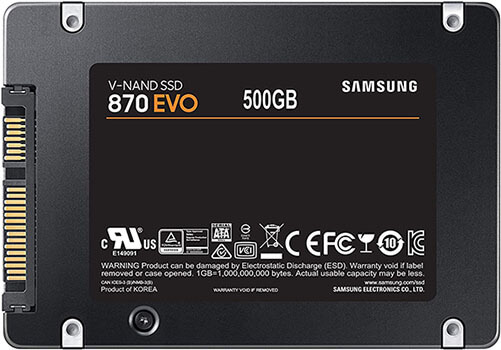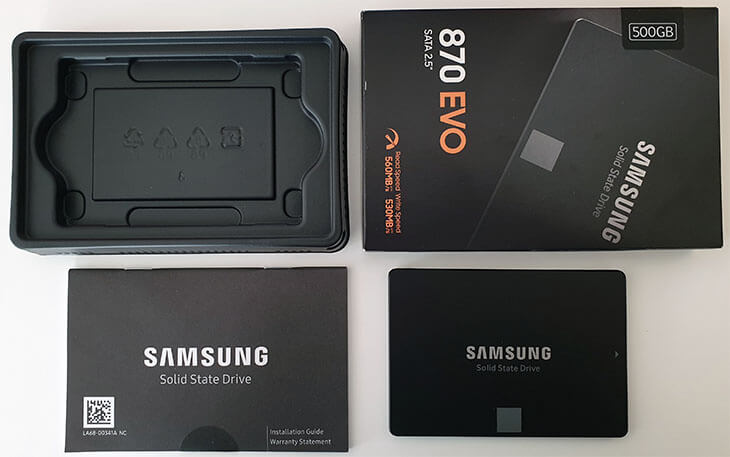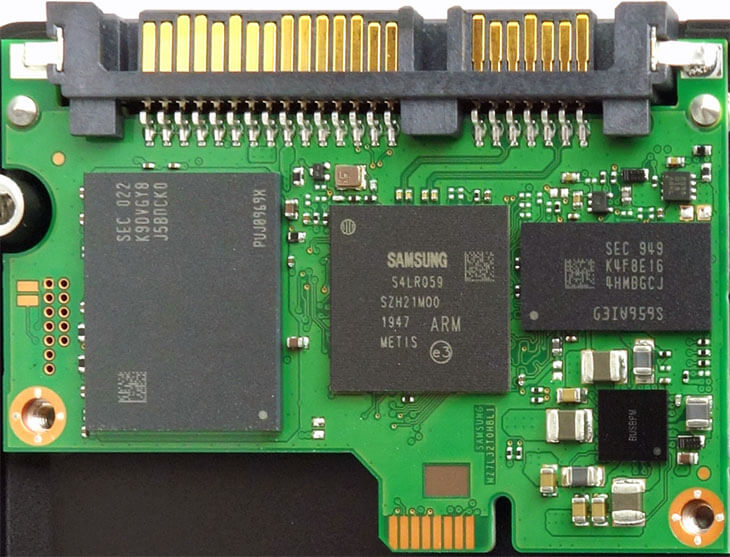
Samsung 870 Evo SSD Review: Impressive Performance
Introduction

Samsung's consumer line SSDs are highly successful, especially the EVO series. The company has recently launched the 870 EVO which is the successor of their popular 860 EVO that was released more than 2 years ago. Samsung's new 870 EVO series range from 250GB and up to 4TB and feature the company's new 128-layer 3D NAND flash technology. The 128-layer NAND is said to offer improvements in read latency and power consumption.
The 870 Evo features a 5-year limited warranty and retails for $40 (250GB), $70 (500GB), $130 (1TB), $250 (2TB), and $480 (4TB). Samsung uses the updated MKX controller in the 870 Evo which is also used in the 870 QVO SDDs so we should expect a nice performance bump across the board. Today we will be reviewing the 870 Evo 500GB model and we will be comparing it against other SATA drives that are on the market.

Samsung advertises the 870 Evo series with sequential read speeds of up to 560 MB/s and sequential write speeds of up to 530 MB/s for all capacities. Random write speeds for all capacities is rated for up to 88K IOPS and 98K IOPS for random read speeds. The new 128-layer NAND along with the new MKX controller is able to deliver improved sequential write speeds and random write speeds compared to the previous generation.
Pricing & Endurance
Samsung's 3D-NAND technology is built to endure 150TB (TBW) for the 250GB model which equals to about 82GB per day for 5 years. The 500GB and 1TB models can handle up to 300TB and 600TB (TBW) and this amounts to 164GB daily read/write for the 500GB model and 328GB for the 1TB model for 5 years. The 2TB and 4TB models on the other hand can endure up to 1200TB (TBW) and 2400TB (TBW), respectively. This equals to about 657GB per day for 5 years for the 2TB model and 1314GB for the 4TB model.
In this review we will be primarily comparing the Samsung 870 Evo to the Crucial MX500 SSD to see which one offers the best performance. Price-wise, the 870 Evo SSDs are significantly more expensive than the Crucial MX500 drives. For example, the 870 Evo 1TB retails for $130 while the MX500 1TB sells for $90 which makes the MX500 1TB about $40 cheaper. The other MX500 models are just as cheaper but capacity-wise, the MX500 series max out at 2TB while Samsung offers users up to 4TB which is very impressive. Samsung clearly has an advantage in the industry with their 4TB capacity model.
Crucial does have the upper hand in price but that's about it. Samsung's 870 Evo SSDs offer much higher write endurance than the competition. Crucial's MX500 1TB drive can only endure 360TB (TBW) while the 870 Evo 1TB almost doubles that with up to 600TB TBW. The MX500 500GB comes with 180TB (TBW) which is almost half of the 870 Evo 500GB that endures up to 300TB (TBW). The difference in write endurance increases even more if we compare the 2TB model. We are looking at up to 1,200TB (TBW) for the 870 Evo 2TB versus 700TB (TBW) for the MX500 2TB.
Features
The 870 Evo supports many advance features such as Self Monitoring and Reporting Technology (SMART) which is basically a monitoring system used to perform an analysis of the drive for problems with the intent of anticipating hardware failures. It also comes with support for error correction codes (ECC) which are used in NAND Flash memories to detect and correct bit-errors. TRIM is also supported in the 870 Evo which basically means the operating system can inform the SSD which blocks of data are no longer in use and can be wiped internally to improve performance.
The 870 Evo has up to six times longer sustained performance than its predecessor due to enhanced Intelligent TurboWrite. The TurboWrite buffer size varies based on the capacity of the SSD; 12GB for 250GB model, 22GB for 500GB model, 42GB for 1TB model and 78GB for 2/4TB models. With the TurboWrite technology, a part of the 3D V-NAND memory (3 bits per cell) acts as SLC memory (one bit per cell) and this portion of the NAND memory in the disk acts as a specific buffer through which all data write operations pass.
Samsung's MKX controller comes with support for Opal/TCG V2.0 encryption which you can use to keep your personal files and confidential data restricted from hackers and thieves with AES 256-bit hardware-based encryption. Being hardware-based means that the encryption engine secures your data without the performance degradation that you may experience with software-based encryption.
These are all the advanced features the Samsung 870 Evo supports:
- Error Correction Code (ECC)
- Garbage Collection
- TRIM Support
- Self-Monitoring and Reporting Technology (SMART)
- AES 256-bit Full Disk Encryption
- TCG/Opal V2.0
- TurboWrite Technology
- Encrypted Drive (IEEE1667)
Specifications
| Samsung 870 Evo Series Lineup | |||||
|---|---|---|---|---|---|
| Model | 250GB | 500GB | 1TB | 2TB | 4TB |
| Price | $39.99 | $69.99 | $129.99 | $249.99 | $479.99 |
| Interface | SATA III 6Gb/s | ||||
| Protocol | AHCI | ||||
| Form Factor | 2.5" | ||||
| Dimensions | 100x 69.85x 6.8 (mm) | ||||
| Controller | Samsung MKX | ||||
| DRAM (LPDDR4) | 512MB | 1GB | 2GB | 4GB | |
| NAND | Samsung 512Gbit 128L 3D TLC | ||||
| Sequential Read | 560 MB/s | ||||
| Sequential Write | 530 MB/s | ||||
| Random Read | 98K IOPS | ||||
| Random Write | 88K IOPS | ||||
| SLC Write Cache | 12 GB | 22 GB | 42 GB | 78 GB | 78 GB |
| Endurance (TBW) | 150 TB | 300 TB | 600 TB | 1,200 TB | 2,400 TB |
| TRIM supported | Yes | ||||
| Encryption | AES 256-bit encryption | ||||
| Warranty | 5 Years | ||||
| Launch Date | January 2021 | ||||
Packaging

The front of the package lists sequential read and write speeds and the capacity which is located on the top right corner. On the back you will find a large sticker displaying similar information such as model, serial number, capacity and warranty information. The 870 Evo comes in a black aluminum enclosure and has a light gray square under the Samsung branding. Like most SATA SSDs, the 870 Evo utilizes the SATA III 6Gbps interface but it is compatible with SATA II and SATA I interfaces, but that means it will work at a reduced speed.
When you first install a Samsung SSD, I highly recommend downloading and installing Samsung's Magician software because it helps enhance the performance of your SSD by allowing you to update the firmware, over-provision, secure-erase, track the health of the SSD and you can also see how much storage you’ve used. When you are inside the Samsung Magician software, make sure to head over to the OS Optimization screen to configure your OS to work best with the SSD. By default, index searching, prefetch, superfetch are enabled so you can disable them because they are not needed if you are using an SSD and I would also set the power options to high performance.

Above you will see a picture of the PCB of the 870 Evo model which has just three components on it. There is the MKX controller, a 128-layer NAND package and a LP-DDR4 DRAM module. The 250GB/500GB models get 512MB DRAM cache buffer while the bigger 1TB, 2TB and 4TB models come with 1GB, 2GB and 4GB DRAM cache buffer, respectively.
Test Methodology
| Test Setup | |
|---|---|
| Processor | AMD Ryzen 7 3700X oc'd 4.2Ghz |
| Motherboard | ASUS ROG STRIX X470-F |
| RAM | Ballistix Elite 16GB (2x8GB) DDR4 3200 MHz |
| Graphics Card | Nvidia GeForce RTX 3070 FE |
| Storage | Samsung 970 Evo Plus 500GB Samsung 870 Evo 500GB Samsung 860 Evo 500GB Western Digital Black 3D 500GB Crucial P1 500GB Crucial MX500 500GB Toshiba TR200 480GB |
| Power Supply | Seasonic Focus Plus 750W Gold |
| Heatsink | Noctua NH-U14S |
| OS | Windows 10 Pro 64-Bit (20H2) |
| Thermal Compound | Noctua NT-H1 |
| Case | Open bench |
To make sure these drives perform at their maximum performance, we will be disabling all the power saving features in the BIOS (C6-state, etc). The testing was done on a fresh install of Windows 10 64-bit with the latest windows updates installed. We disabled a bunch of unnecessary services such as drive indexing, Prefetch, Superfetch, Defrag and removed all the bloatware from Windows 10 to make sure there were as few processes running as possible during the testing.
We'll be using the AMD Ryzen 7 3700X processor all-cores overclocked to 4.2Ghz and the ASUS ROG STRIX X470-F motherboard
with the latest BIOS version installed which at the time of writing this review is v5809.
Installing and using an SSD is pretty straight forward, simply connect one end of your SATA cable to the SATA port in your motherboard and the other end of the cable to your SSD.
After installing windows, make sure to check if you have the latest firmware.
Benchmark Software:
+ Windows 10 Startup
+ HD Tune Pro
+ ISO File Copy
+ AS SSD Read/Write
+ AS SSD Score
+ IOMeter
Benchmark Results
| Windows 10 Startup Time | |
|---|---|
| SSDs | Seconds (lower is better) |
| Samsung 970 Evo Plus 500GB | 6.8s |
| Samsung 870 Evo 500GB | 7.1s |
| Samsung 860 Evo 500GB | 7.1s |
| Crucial P1 500GB | 7.2s |
| Crucial MX500 500GB | 7.6s |
| Toshiba TR200 480GB | 8.4s |
Windows 10 boot times are measured from the time it takes between hitting the power button to reaching the Windows desktop.
| AS-SSD Score Benchmark | |
|---|---|
| SSDs | Score (higher is better) |
| Samsung 970 Evo Plus 500GB | 4931 |
| Crucial P1 500GB | 2691 |
| Samsung 870 Evo 500GB | 1242 |
| Samsung 860 Evo 500GB | 1238 |
| Crucial MX500 500GB | 1231 |
| Toshiba TR200 480GB | 823 |
The AS-SSD software is a popular benchmarking software used to measure the performance of an SSD. In this test we are measuring the overall score.
| AS-SSD Sequential Benchmark | |
|---|---|
| SSDs | Read/Write (higher is better) |
| Samsung 970 Evo Plus 500GB | 3285 MB/s (write) 3503 MB/s (read) |
| Crucial P1 500GB | 1527 MB/s (write) 1829 MB/s (read) |
| Samsung 870 Evo 500GB | 549 MB/s (write) 558 MB/s (read) |
| Samsung 860 Evo 500GB | 531 MB/s (write) 549 MB/s (read) |
| Crucial MX500 500GB | 529 MB/s (write) 548 MB/s (read) |
| Toshiba TR200 480GB | 452 MB/s (write) 508 MB/s (read) |
Once again, we are using the AS-SSD software to measure sequential read and write speed of each drive.
| IOMeter 4KB Benchmark | |
|---|---|
| SSDs | Read/Write (higher is better) |
| Samsung 970 Evo Plus 500GB | 241162 KB/s (write) 281266 KB/s (read) |
| Crucial P1 500GB | 228481 KB/s (write) 271437 KB/s (read) |
| Samsung 870 Evo 500GB | 89161 KB/s (write) 98045 KB/s (read) |
| Samsung 860 Evo 500GB | 89148 KB/s (write) 98029 KB/s (read) |
| Crucial MX500 500GB | 89353 KB/s (write) 98246 KB/s (read) |
| Toshiba TR200 480GB | 71692 KB/s (write) 95381 KB/s (read) |
In this test, we are using IOMeter which is one of the best application for stress testing the random IO performance of an SSD. IOMeter is set to use 4KB file size chunks and will stress the SSD with random 4 KB files.
| HD Tune Pro IOPS Benchmark | |
|---|---|
| SSDs | Read/Write (higher is better) |
| Samsung 970 Evo Plus 500GB | 2681 MB/s (write) 2932 MB/s (read) |
| Crucial P1 500GB | 1611 MB/s (write) 2087 MB/s (read) |
| Samsung 870 Evo 500GB | 519 MB/s (write) 517 MB/s (read) |
| Samsung 860 Evo 500GB | 513 MB/s (write) 513 MB/s (read) |
| Crucial MX500 500GB | 488 MB/s (write) 511 MB/s (read) |
| Toshiba TR200 480GB | 479 MB/s (write) 508 MB/s (read) |
Here we are using HD Tune Pro to measure read and write IOPS. HD Tune Pro is a Hard Disk Utility with many functions such as error checking, S.M.A.R.T and benchmarking.
| ISO File Copy Benchmark | |
|---|---|
| SSDs | Seconds (lower is better) |
| Samsung 970 Evo Plus 500GB | 4.2s |
| Crucial P1 500GB | 7.3s |
| Samsung 870 Evo 500GB | 13.5s |
| Samsung 860 Evo 500GB | 13.7s |
| Crucial MX500 500GB | 13.9s |
| Toshiba TR200 480GB | 16.3s |
To represent a large file usage scenario, we are copying a 5GB ISO image to a different folder on the same drive.
Conclusion
The 870 EVO is an impressive SATA SSD and it delivers the best SATA performance I have seen.
It comes loaded with features such as hardware-based encryption, great read/write performance and high write endurance.
With the 870 Evo, Samsung has managed to squeeze every last bit of performance out of the SATA III interface which is awesome to see.
But I will say that the performance difference going from the 860 Evo to 870 Evo is tiny.
Pros:
+ Fantastic Performance
+ Up To 4TB Capacity
+ Samsung Magician Software
+ Hardware-Based Encryption
+ 5-Year Warranty
Cons:
- Pricier Than Competition
The biggest downside of the 870 Evo 500GB is its high price-tag and there are plenty of SSDs on the market that deliver close to the
performance of the 870 Evo while being significantly cheaper.
At $130, the 870 Evo 500GB costs about $40 more than the Crucial MX500 500GB which retails for $90 and the performance
difference between the two SSDs is very small.
If you are on a tight budget, we recommend going with the MX500 500GB since it offers similar performance at a much attractive price.
But if you're looking to buy the absolute best performing SATA SSD on the market regardless of price, the new Samsung 870 Evo SSDs are what you should be looking at. If you are using a traditional hard drive, then you should definitely consider upgrading to an SSD because it will offer a massive improvement in every aspect from read/write speeds to access times to power consumption. With the release of the 870 Evo, Samsung continues to dominate the consumer SSD industry with the fastest SATA SSD on the market. Overall, I believe the Samsung 870 Evo 500GB SSD deserves our Gold award.
Final Score 9.5
